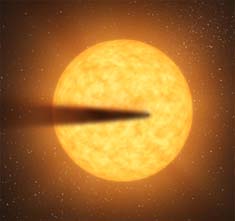The Observatoire Mont-Mégantic and researchers from the CRAQ witness the upcoming disintegration of a planet
 A research team led by researchers from the MIT and NASA, including two researchers from the CRAQ (Bishop’s University and Université Laval), demonstrated the upcoming disintegration of a planet around its host star. This cataclysmic event, which will happen in the next 100 millions of years, was evidenced by data from the Kepler space telescope and the telescope at the Observatoire Mont-Mégantic.
A research team led by researchers from the MIT and NASA, including two researchers from the CRAQ (Bishop’s University and Université Laval), demonstrated the upcoming disintegration of a planet around its host star. This cataclysmic event, which will happen in the next 100 millions of years, was evidenced by data from the Kepler space telescope and the telescope at the Observatoire Mont-Mégantic.
The planet, located about 1500 light years from our Solar System, seems to be evaporating under the strong solar winds from the host star. This small planet, barely larger than Mercury in our Solar System, behaves similarly to a comet, with a long tail of dusts and debris caused by the stellar blow from the star KIC 12557548.
The team of researchers from the MIT (Massachusetts Institute of Technology) and from NASA discovered the planets, using the Kepler space telescope, and deduced its properties using sophisticated photometric methods. The small planet is very intriguing because of its very small orbital period (it goes around the host star once every 15 hours), and its great proximity to the star. Under these two conditions, the planet is heated to high temperatures by the parent star KIC 12557548. To determine the unknown properties of the star, the researchers called in collaborators from the Centre de Recherche en Astrophysique du Québec (CRAQ) and from the Observatoire Mont-Mégantic (OMM).
Despite its modest size, the telescope at the OMM is equipped with cutting-edge instruments, including a spectrograph designed, partly, to understand the properties of stars. Solicited by the MIT/NASA team, Prof. Lorne Nelson from Bishop’s University, and PhD student Laurie Rousseau-Nepton from Université Laval, acquired spectral data at the OMM, despite the relatively low brightness of the star. By comparing the obtained spectra to theoretical models, the researchers determined the properties (mass, temperature, and stellar type) of the star KIC 12557548.
Overall, the combination of data from Kepler and the OMM showed that the planet is orbiting a star similar to our Sun, but with a surface temperature a little bit cooler (4200 degrees Celsius) than our Sun (5500 degrees Celsius). Because the planet orbits the star once every 15h, and at short distance, the surface of the planet reaches temperatures of 3200 degrees Celsius, melts and evaporates, causing a tail of debris and dusts. This phenomenon is very similar to that of comets in our Solar System.
This discovery is published in June 2012 in “The Astrophysical Journal, vol. 752, issue 1.”
http://arxiv.org/abs/1201.2662
Illustration: Artistic representation of the planet disintegrating in front of its star.
Renseignement :
Olivier Hernandez, Ph.D.
Relation avec les médias
CRAQ – Université de Montréal
Tél. : 514-343-611,1 poste 4681
olivier@astro.umontreal.ca | @OMM_Officiel | @CRAQ_Officiel
